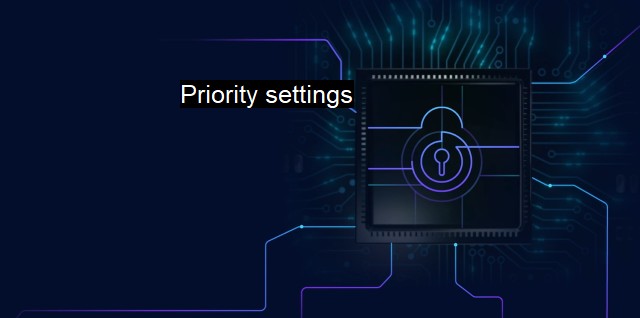What are Priority settings?
Maximizing Cybersecurity Efficiency through Priority Settings in Antivirus Software
Priority settings in the context of cybersecurity and antivirus refers to the ability of nowadays IT systems to configure various cybersecurity protocols, antivirus applications, and system applications in different orders based on their importance and precedence.One of the most integral parts of any digital platform, business, or personal system is cybersecurity. It entails protecting computers, servers, networks, and data from digital attacks that may compromise, destroy or steal information. Amongst the dynamic tools of cybersecurity are antiviruses, which are software designed to detect, nullify or remove malicious software- often known as malware- from an IT ecosystem. Cybercriminals initiate malware to gain unauthorized access, steal data, or disrupt systems.
The priority settings within cybersecurity and antivirus is a decisive technique to help the system timely manage and respond to varying levels of threats. The order of these settings is significant because it predicates how the system first responds to the multitude of potential threats.
Priority settings are initiated in the administration panel of antivirus software and cybersecurity systems. Administrators can select which types of scans (e.g., quick scans, customizable scans, or full system scans) or actions take precedence over others. They may also prioritize the system processes and monitor the usage of system resources like Memory and CPU.
Administrators can opt to alter these settings and place more urgency on user surveillance and location-based violations or focus more efforts on tracking code-based violations. The hierarchy of alerts can be adjusted based on the user behavior, enterprise activities, and threat occurrence patterns. This level of customization can empower businesses to facilitate effective, real-time threat management and to maximize the efficiency of their cybersecurity tactics.
In a large scale enterprise setting, many antivirus or intrusion-detection systems may be running concurrently, each addressing diverse threats. Here, priority settings enable administrators to determine which systems or scanned areas require immediate attention over others.
Modern cybersecurity is driven by layers, and priority settings also play a vital role in layered defense strategy or defense-in-depth. This approach centers around the principle that no single layer of defense can fully protect against all possible threats. Rather, each layer is set with a specific range of defensive and protective tasks. Priority settings help to categorize these tasks based on their importance and criticality.
Priority settings also help to maintain an optimal balance between security procedures and device performance. Lowering the priority of an antivirus software may deem necessary when it devours a major chunk of system resources, which could instigate adverse effects on system functionality. In contrast, raising the priority may also limit other programs' performance.
False positives or unnecessary alerts are another aspect where priority setting is significant, help in reducing noise, and focusing more effectively on actual threats.
Priority settings in cybersecurity and antivirus software present a more bespoke, tailor-made approach to security apparatus. conferences must be exercised when creating these settings since an overemphasis on lesser-threat elements may leave the system exposed to more destructive threats.
Priority settings are a cornerstone in cybersecurity that allows real-time response, efficient threat management, and maintaining system operation-'nobility. Specifically, in antivirus programs, it ensures that different software scans are carried out in the correct order, ensuring maximum protection against potential risks.

Priority settings FAQs
What are priority settings in the context of cybersecurity and antivirus software?
Priority settings refer to the ability to define the order or level of importance of various tasks or operations performed by a cybersecurity or antivirus software. This can include scanning, updates, and threat detection, among others. By setting priority levels, users can customize their software to focus on the most critical tasks first and optimize system performance.How can priority settings help improve cybersecurity and antivirus protection?
By setting priority levels and focusing on critical tasks first, users can ensure that their antivirus and cybersecurity software is actively protecting them against the latest threats. This can help eliminate vulnerabilities and reduce the risk of cyber attacks. Furthermore, prioritizing scans and updates can help improve the overall performance of the system and minimize any disruptions caused by the software.Can priority settings be adjusted for different users or devices?
Yes, most cybersecurity and antivirus software allows users to customize priority settings based on their specific needs and devices. For example, a business may prioritize network security and malware detection on their servers while focusing on email security and phishing protection on their employees' devices. This flexibility allows users to tailor their cybersecurity solutions to their unique environments and security requirements.Are there any drawbacks to adjusting priority settings?
While adjusting priority settings can help improve system performance and enhance security, it is important to ensure that critical tasks are always being performed in a timely manner. If lower priority tasks are given too much attention or higher priority tasks are neglected, this can leave the system vulnerable to potential threats. Additionally, adjusting priority settings may require some trial and error to find the optimal balance between performance and security.| | A | | | B | | | C | | | D | | | E | | | F | | | G | | | H | | | I | | | J | | | K | | | L | | | M | |
| | N | | | O | | | P | | | Q | | | R | | | S | | | T | | | U | | | V | | | W | | | X | | | Y | | | Z | |
| | 1 | | | 2 | | | 3 | | | 4 | | | 7 | | | 8 | | |||||||